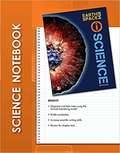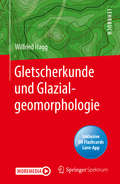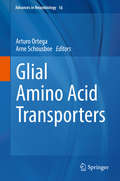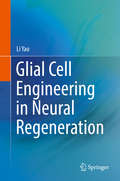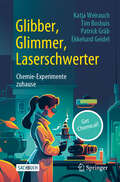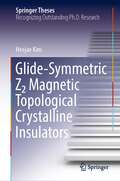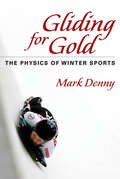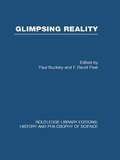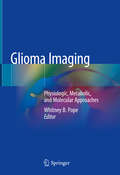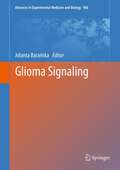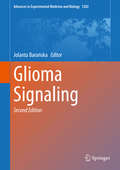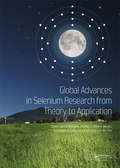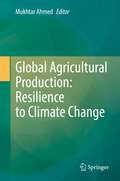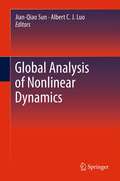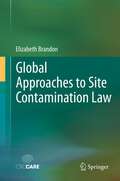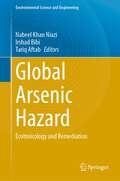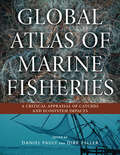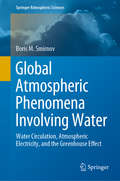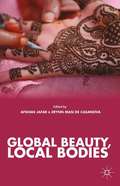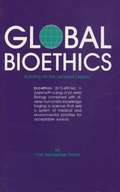- Table View
- List View
Glencoe World Geography: A Physical and Cultural Approach
by Richard G. BoehmThe book covers the development of geography in various regions in three categories: physical, cultural and current.
Glencoe World Geography: A Physical and Cultural Approach (3rd edition)
by James L. Swanson Richard G. BoehmGeography textbook.
Glencoe iScience: Earth and Space Science Notebook, Grade 6 (Earth Science)
by McGraw-Hill EducationBased on the Cornell note-taking format, this resource incorporates writing into the learning process. Directly linked to the student text, this notebook provides a systematic approach to learning science by encouraging students to engage by summarizing and synthesizing abstract concepts in their own words
Gletscherkunde und Glazialgeomorphologie
by Wilfried HaggDieses Lehrbuch behandelt alle wichtigen Aspekte zu Gebirgsgletschern, von ihrer Entstehung über ihre Bedeutung als Wasserspeicher bis hin zu ihrer Bedrohung durch die aktuelle Klimaerwärmung. Gletscher können auch selbst zur Bedrohung für den Menschen werden und in Form von Eislawinen und Gletscherseeausbrüchen eine Naturgefahr in besiedelten Gebirgsräumen darstellen. Daneben sind sie aber auch wichtige Landschaftsformer und haben große Teile des heutigen Erdreliefs mitgestaltet, was zu den klassischen Arbeitsfeldern von Geomorphologie und Geologie gehört. In den einzelnen Kapiteln wird der aktuelle Forschungsstand nachvollziehbar präsentiert und anhand prägnanter Beispiele, Fotos und Grafiken veranschaulicht. Aufgrund der Dominanz des Englischen als Wissenschaftssprache werden deutsche Fachbegriffe dort, wo es sinnvoll und nötig ist, der englischen Terminologie gegenübergestellt.Das Buch bietet eine kompakte Einführung für alle Studierenden der Geowissenschaften, neugierige Bergsteiger und naturinteressierte Laien. Ein Glossar erklärt über 250 Fachbegriffe von A wie Ablation bis Z wie Zungenbecken. Zusätzliche Fragen zum Selbsttest per App: Laden Sie die Springer Nature Flashcards-App kostenlos herunter und nutzen Sie exklusives Zusatzmaterial, um Ihr Wissen über Rundhöcker, Drumlins und Moränen zu prüfen.
Glial Amino Acid Transporters
by Arne Schousboe Arturo OrtegaThis ambitious compendium provides an extensive overview on the "supporting cells" of the vertebrate central nervous system, these being glial cells which far outnumber neurons but are much less understood. Covering multiple aspects of this family of transporters-- from structural properties, to their involvement in signaling and gene expression regulation, this volume presents the most recent research on the roles of glial amino acid transporters as key molecules of brain metabolism and signaling.
Glial Cell Engineering in Neural Regeneration
by Li YaoThis book focuses on current applications of glial cells in neural regeneration, especially in spinal cord repair. It introduces the application of a few types of glial cells including oligodendrocyte, astrocyte, Schwann cells, and stem cell derived glial cells in neural regeneration. The latest glial cell research with biomaterials, gene modification, and electrical signals is also summarized. This is an ideal book for undergraduate and research students in tissue engineering, neurobiology, and regenerative medicine as well as researchers in the field.
Glibber, Glimmer, Laserschwerter: Chemie-Experimente zuhause
by Katja Weirauch Tim Boshuis Patrick Gräb Ekkehard GeidelDieses Buch ist für alle TüftlerInnen geschrieben, die die Blaukraut- und Backpulver-Experimente aus dem Internet schon alle durchprobiert haben und denen der Chemiebaukasten auch nichts Neues mehr bieten kann. Ihr müsst nicht auf die nächste Chemiestunde in der Schule warten, um weitermachen zu können!Um Chemie zu betreiben, braucht man nicht unbedingt ein Labor. Chemische Experimente durchführen bedeutet aber auch nicht, einfach alles zusammenzuschütten, was der Putzschrank oder der Kühlschrank hergeben. Abgesehen davon, dass das durchaus gefährlich werden kann, passiert oft nichts. Oder es passiert etwas und keiner ist da, der einem erklären könnte, warum. Mit diesem Buch möchten wir euch Ideen und erste Anleitungen geben, mit denen ihr selbst weiterforschen könnt. Nach einer ersten Erklärung folgen mehrere Versuche, mit denen ihr eine chemische Untersuchungsmethode trainieren könnt – die euch fit machen soll, um dann euren eigenen Ideen nachgehen zu können. Für die Versuche benötigt ihr zum Teil besondere Materialien, die man aber alle käuflich erwerben kann. Legt los!
Glide-Symmetric Z2 Magnetic Topological Crystalline Insulators (Springer Theses)
by Heejae KimThis book presents a comprehensive theory on glide-symmetric topological crystalline insulators. Beginning with developing a theory of topological phase transitions between a topological and trivial phase, it derives a formula for topological invariance in a glide-symmetric topological phase when inversion symmetry is added into a system. It also shows that the addition of inversion symmetry drastically simplifies the formula, providing insights into this topological phase, and proposes potential implementations. Lastly, based on the above results, the author establishes a way to design topological photonic crystals. Allowing readers to gain a comprehensive understanding of the glide-symmetric topological crystalline insulators, the book offers a way to produce such a topological phase in various physical systems, such as electronic and photonic systems, in the future.
Gliding for Gold: The Physics of Winter Sports
by Mark DennyAs anyone from cold climates knows, living with lots of ice and snow can lead to a special appreciation of sports such as skiing, sledding, and skating. Prolific physics popularizer Mark Denny’s take on winter athletics lays out the physical principles that govern glaciated game play.After discussing the physical properties of ice and snow and describing the physics behind sliding friction and aerodynamic drag, Denny applies these concepts to such sports as bobsledding, snowboarding, and curling. He explains why clap skates would only hinder hockey players, how a curling rock curls, the forces that control luge speed, and how steering differs from skiing to snowboarding. With characteristic accuracy and a touch of wit, Denny provides fans, competitors, and coaches with handy, applicable insights into the games they love. The separate section of technical notes offers an original and mathematically rigorous exploration of the key aspects of winter sports physics. A physics-driven exploration of sports played on ice and snow that is truly fun and informative, Gliding for Gold is the perfect primer for understanding the science behind cold weather athletics.
Glimpsing Reality: Ideas in Physics and the Link to Biology (Routledge Library Editions: History & Philosophy of Science)
by Paul & Buckley & PeatOriginally published in 1979. This reprints the revised and expanded edition of 1996. In this volume, physicists, biologists and chemists, who have been involved in some of the most exciting discoveries in modern scientific thought explore issues which have shaped modern physics and which hint at what may form the next scientific revolution. The major issues discussed are the understanding of time and space, quantum and relativity theories and recent attempts to unite them and related questions in theoretical biology.
Glioma Imaging: Physiologic, Metabolic, and Molecular Approaches
by Whitney B. PopeThis book covers physiologic, metabolic and molecular imaging for gliomas. Gliomas are the most common primary brain tumors. Imaging is critical for glioma management because of its ability to noninvasively define the anatomic location and extent of disease. While conventional MRI is used to guide current treatments, multiple studies suggest molecular features of gliomas may be identified with noninvasive imaging, including physiologic MRI and amino acid positron emission tomography (PET). These advanced imaging techniques have the promise to help elucidate underlying tumor biology and provide important information that could be integrated into routine clinical practice. The text outlines current clinical practice including common scenarios in which imaging interpretation impacts patient management. Gaps in knowledge and potential areas of advancement based on the application of more experimental imaging techniques will be discussed. In reviewing this book, readers will learn: current standard imaging methodologies used in clinical practice for patients undergoing treatment for glioma and the implications of emerging treatment modalities including immunotherapythe theoretical basis for advanced imaging techniques including diffusion and perfusion MRI, MR spectroscopy, CEST and amino acid PET the relationship between imaging and molecular/genomic glioma features incorporated in the WHO 2016 classification update and the potential application of machine learningabout the recently adopted and FDA approved standard brain tumor protocol for multicenter drug trialsof the gaps in knowledge that impede optimal patient management and the cutting edge imaging techniques that could address these deficits
Glioma Signaling
by Jolanta BarańskaGlioma Signaling is a text reference on cellular signaling processes focused on the mechanism of nucleotide receptors activation by exogenic nucleotides and the formation of complex signaling cascades, including cytoplasmic transcription factors, induced by growth factors, cytokines and cannabinoids. The book provides a framework explaining how signal transduction elements may modulate glioma cytoskeleton structure, cytoplasmic calcium concentration changes, cellular growth, progression and invasion, as well as presents perspective concerning potential targets for glioma therapy.
Glioma Signaling (Advances in Experimental Medicine and Biology #1202)
by Jolanta BarańskaGliomas, developing in the brain from the transformed glial cells, are a very special kind of tumor, extremely refractory to conventional treatments. Therefore, for the development of new antitumor strategies, a better understanding of molecular mechanisms responsible for their biology, growth and invasion is still needed. This book is a reference on cellular signaling processes regulating gliomas physiology and invasiveness. The work is focused on the mechanism of nucleotide receptor activation by exogenous nucleotides and formation of complex signaling cascades induced by growth factors, cytokines and cannabinoids. The second edition of the book enriched in new chapters provides a framework explaining how signal transduction elements may modulate numerous genetic and epigenetic alterations, describes the role of local microenvironment in cellular growth, progression and invasion and, in the light of extensive new results, presents perspectives concerning potential targets for gliomas therapy.
Glitter Everywhere!: Where it Came From, Where It's Found & Where It's Going
by Chris BartonFans of How It&’s Made will love this fresh, irreverent look at the science and story behind glitter.If you love glitter, this book is for you. If you hate glitter, this book is also for you.Everyone seems to have an opinion about glitter. But how much do you know about the tiny, shiny confetti? What makes glitter glitter? Why does it stick to everything? Who invented it? How is it made? Is glitter bad for the environment?Chris Barton&’s informative wit and Chaaya Prabhat's vibrant art make Glitter Everywhere sparkle as it covers the good, the bad, and shiny of all things glitter.
Global Advances in Selenium Research from Theory to Application: Proceedings of the 4th International Conference on Selenium in the Environment and Human Health 2015
by Zhi-Qing Lin Gary S. Bañuelos Milton Ferreira de Moraes Luiz Roberto G. Guilherme André Rodrigues dos ReisThe 4th International Conference on Selenium in the Environment and Human Health was held 18-21 October 2015 in S�Paulo, Brazil. This conference provided an effective scientific communication platform for researchers in different disciplines worldwide to elucidate and better understand those complex roles of Se as both essential nutrient and enviro
Global Agricultural Production: Resilience to Climate Change
by Mukhtar AhmedThis book covers all aspects related to climate change and agriculture. The book discusses Global Climate Models (GCMs), Coupled Model Intercomparison Project (CMIP) and application of strategic management tool that includes RCP (Representative concentration Pathway), SSP (Shared Socio-economic Pathways) and SPA (Shared climate Policy Assumptions). The book provides information on how climate change, agricultural productivity and food security are interlinked. The impacts of climate change on food security are studied through different climatic drivers e.g., ENSO (El Niño–Southern Oscillation) and SOI (Southern Oscillation Index). These drivers are responsible for the climatic extreme events hence early prediction of these drivers could help to design appropriate adaptive measures for the agriculture sector and could be considered as early warning tools for risk management. Similarly, climate change and process-based soil modeling as well as the role of soil microbes and climate smart agriculture are discussed in this book. Climate change impacts on legume crop production and adaptation strategies are presented, with details about cereal crop modeling, perspectives of Camelina sativa as well as low input biofuel and oilseed crop, greenhouse gases (GHGs) emissions and mitigation strategies.
Global Analysis of Nonlinear Dynamics
by Albert C. Luo Jian-Qiao SunGlobal Analysis of Nonlinear Dynamics collects chapters on recent developments in global analysis of non-linear dynamical systems with a particular emphasis on cell mapping methods developed by Professor C.S. Hsu of the University of California, Berkeley. This collection of contributions prepared by a diverse group of internationally recognized researchers is intended to stimulate interests in global analysis of complex and high-dimensional nonlinear dynamical systems, whose global properties are largely unexplored at this time.
Global Approaches to Site Contamination Law
by Elizabeth BrandonThe book describes the complex and variable laws addressing site contamination, reviewing existing international, regional and national law of relevance to site contamination. It also offers detailed case studies of national approaches to the issue, and goes on to explore avenues for promoting the development of comprehensive domestic laws on site contamination, with a focus on the role of international law and actors. A detailed discussion analyzes such variations as a binding international legal instrument, a non-binding instrument, and a model framework for site contamination management. The text includes recommendations regarding the key elements needed for regulating site contamination at the national level. The author also offers an appropriate and feasible timetable for international action to promote better national law and policy regarding contaminated sites.
Global Arsenic Hazard: Ecotoxicology and Remediation (Environmental Science and Engineering)
by Tariq Aftab Nabeel Khan Niazi Irshad BibiThis book provides a plethora of information about global arsenic (As) contamination and the challenges for environment. Arsenic is a naturally occurring metalloid that is widely distributed in water, soil, air and biota from natural and anthropogenic sources. Arsenic has been found in drinking water in over 100 countries worldwide, which caused a major public health issue including: cardiovascular disorders, diabetes, and cancers of various organs - these are some of the general health effects of As exposure. Exposure of plants to As, even at very low concentrations, can cause many morphological, physiological, and biochemical changes. The recent research on As in the water-soil-plant-human systems indicates that As toxicity to plants varies with As speciation in plants, type of plant species and with other soil factors controlling As accumulation in plants. In recent years, the development of efficient green chemistry methods for detoxification of trace metal poisoning has become a major focus of researchers. It has been investigated in order to find an eco-friendly and recyclable technique for the removal of As contamination from the natural resources.Understanding the significance of As hazard and roles of sustainable or eco-friendly approaches in its mitigation, we intend to bring forth a comprehensive volume “Global Arsenic Hazard - Ecotoxicology and Remediation" highlighting the various prospects involved in current scenario. We are hopeful that this comprehensive volume will furnish the requisite of all those who are working or have interest in the proposed topic.
Global Atlas of Marine Fisheries: A Critical Appraisal of Catches and Ecosystem Impacts
by Dirk Zeller Daniel PaulyTheGlobal Atlas of Marine Fisheries is the first and only book to provide accurate, country-by-country fishery catch data. This groundbreaking information has been gathered from independent sources by the world's foremost fisheries experts. Edited by Daniel Pauly and Dirk Zeller of the Sea Around Us Project, the Atlas includes one-page reports on 273 countries and their territories, plus fourteen topical global chapters. Each national report describes the current state of the country's fishery; the policies, politics, and social factors affecting it; and potential solutions. The global chapters address cross-cutting issues, from the economics of fisheries to the impacts of mariculture. Extensive maps and graphics offer attractive and accessible visual representations.
Global Atmospheric Phenomena Involving Water: Water Circulation, Atmospheric Electricity, and the Greenhouse Effect (Springer Atmospheric Sciences)
by Boris M. SmirnovThis book covers the role of water in global atmospheric phenomena, focussing on the physical processes involving water molecules and water microparticles. It presents the reader with a detailed look at some of the most important types of global atmospheric phenomena involving water, such as water circulation, atmospheric electricity and the greenhouse effect. Beginning with the cycle of water evaporation and condensation, and the important roles played by the nucleation and growth processes of water microdroplets, the book discusses atmospheric electricity as a secondary phenomenon of water circulation in the atmosphere, comprising a chain of processes involving water molecules and water microdroplets. Finally, the book discusses aspects of the molecular spectroscopy of greenhouse atmospheric components, showing how water molecules and water microdroplets give the main contribution to atmospheric emission in the infrared spectrum range. Featuring numerous didactic schematics and appendices detailing all necessary unit conversion factors, this book is useful to both active researchers and doctoral students working in the fields of atmospheric physics, climate science and molecular spectroscopy.
Global Beauty, Local Bodies
by Erynn Masi de Casanova Afshan JafarWhat do the words global, transnational, national, and local mean when talking about beauty, which is simultaneously abstract and ephemeral, embodied and concrete? How do ideas and images of beauty circulate in a globalizing world, and how do people's bodily practices respond to them? Rather than simply examining how beauty is thought about and aspired to in international settings, this collection of original scholarly work and first-person accounts takes globalization processes and the transnational links these processes create as the jumping-off point for an examination of what it means to be, have, or aspire to a beautiful body.
Global Bioethics: Building on the Leopold Legacy
by Van Rensselaer PotterThis book on Bioethics discusses regarding the Leopold legacy, human survival, dilemmas in ecological Bioethics, two kinds of bioethics, dilemmas in medical bioethics, the control of human fertility and global bioethics defined. Appendix includes the Leopold heritage and a bioethical creed for individuals.

